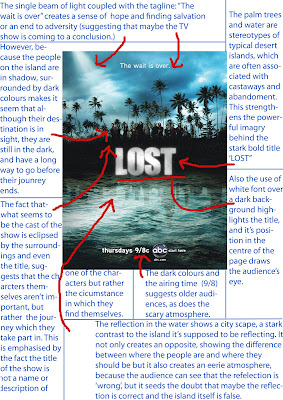My group took inspiration from the print advertisements that came out for "The Boat that Rocked".
The film had several different print adverts that varied across the board which added more information and shots from the film the closer it was to the airing date, we decided to take this approach as well.
I personally researched a print advertisement for 'Lost', a series made for TV. It too has a simple design that draws your eyes inward and makes the audience's curiosity grow. Unlike 'The Boat that Rocked' the 'Lost' advertisement includes a background, but the stark contrast between the sky and the trees simplifys a potentally complex background, and the bold white text of the title draws your eyes to the centre.This too includes little information as it has only the title, a tagline and the name of the channel it runs on, again making the audience actively become involved if they wish to find out more. I included this in my text having only the title and the symbol of the channel it aires on. The title and posing figure in the middle (like 'The Boat that Rocks') draws the eyes to the centre and catches the audiences attention (like 'Lost') I also used simple colours and a fairly simple background as not to distract from the central figure (like both researched texts)
How will your ancillary text appeal to the target audience?
My ancillary text appeals to the target audience mainly because it's eye catching. It's bright and bold and stands out from the pages of a newspaper. The simplicity and bright colours as well as the pixilised style it is drawn in appeals to many teenagers (part of our target audience) and the central figure of the skateboarder of course appeals to others who enjoy the sport be it as a spectator or competetor (another part of our target audience.) The title of 'Hateboarding' will also interest adults and teenagers alike as the pun suggests conflict and a differing of opinion, which are subjects many relish watching on television, and thus this helps not only to appeal to our target audience but also those who may not have previously thought a documentary on skateboarding is something they would be interested in.
Where will the text appear?
The Ancillary text will appear in two places mainly. One is in 'The Metro' a free newspaper that is usually given out near train stations so people can read it during their commute. I would place the advert in there as the text is most likely to have a large amount of views and the chances of the audience for our documentary increasing is likely. It also means that members of our intended target audience, who perhaps might not be able to afford the expensive skateboarding magazines. The other place I would print the advertisement would be a plain TV guide, possibly 'What's on TV?' as it is a staight to television documentary, the majority of our potential audience would read the television guide. Also TV guides aren't limited to age and a huge number of people, young and old, read them and so the market for our documentary may increase.
Why are these formats appropriate?
Making a Print advertisement rather than a television trailer is much more appropriate to our audience. Our documentary is based on Skateboarding which is a main stream sport, and as such many of our audience will be outside and on the move the majority of the time (hence printing it in 'The Metro' a newspaper which frequently swaps hands throughout the day.) Having a trailer would be messy and expensive and there would be no way to guarentee that our target audience would be watching the television during the fleeting minutes the advertisement is run for. If the advert is printed on paper it doesn't matter how many people read it, it will remain there for the next person to read, and wouldn't be so easily missed.
Shona ☺
Shona ☺





















